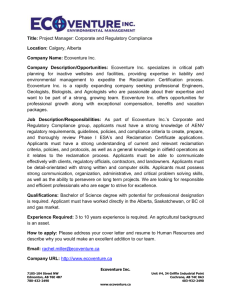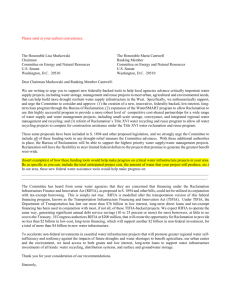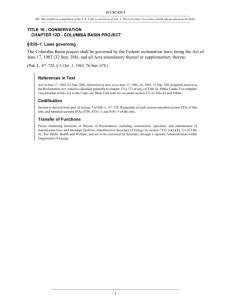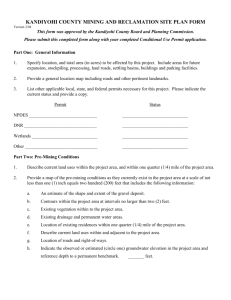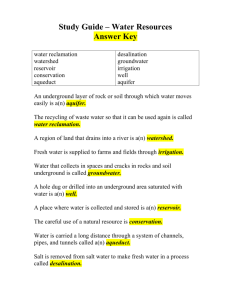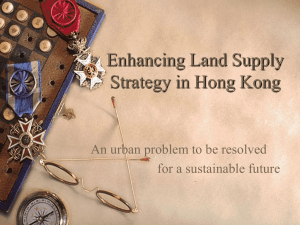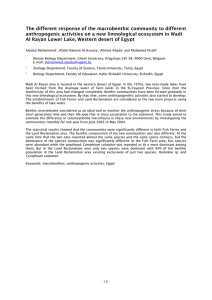Document 11872759
advertisement
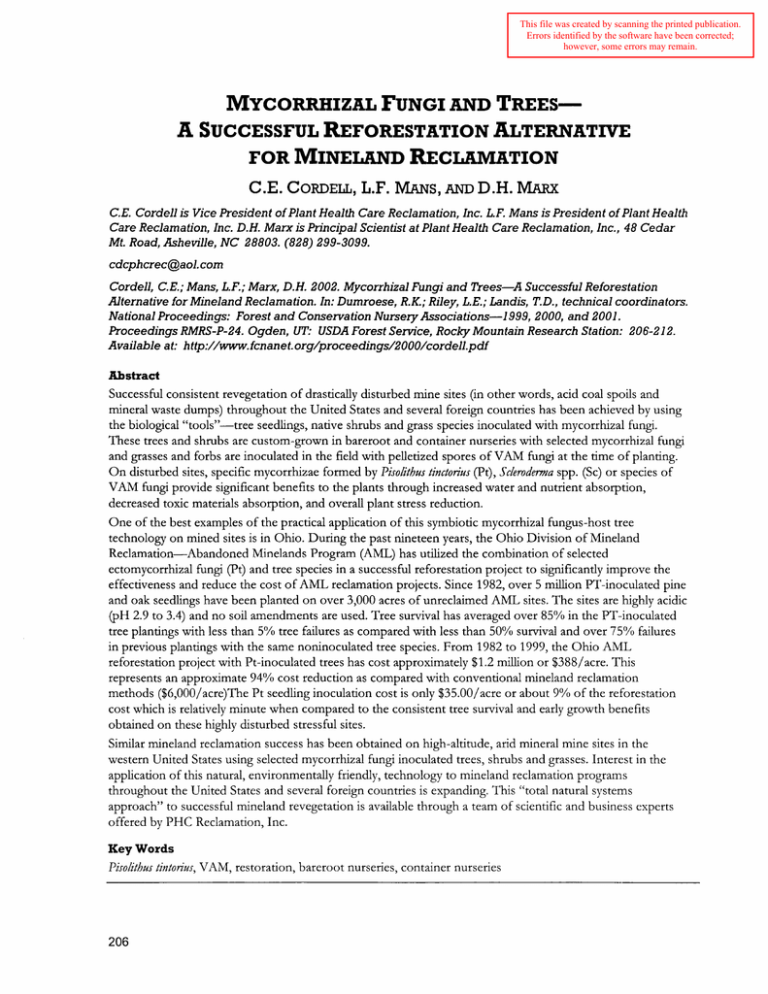
This file was created by scanning the printed publication. Errors identified by the software have been corrected; however, some errors may remain. MYCORRHIZAL FUNGIAND TREESFOR C.E. CORDELL, L.F. MANS,AND D.H. MARX C.E. Cordell is Vice President of Plant Health Care Reclamation, Inc. L.F. Mans is President of Plant Health Care Reclamation, Inc. D.H. Marx is Principal Scientist at Plant Health Care Reclamation, Inc., 48 Cedar Mt. Road, Asheville, NC 28803. (828) 299-3099. cdcphcrec@aol.com Cordell, C.E.; Mans, L.F.; Marx, D. H. 2002. Mycorrhizal Fungi and Trees-A Successful Reforestation Alternative for Mineland Reclamation. In: Dumroese, R.K.; Riley, L.E.; Landis, T.D., technical coordinators. National Proceedings: Forest and ConservationNursery Associa tions-1999,2000, and 2001. Proceedings RMRS-P-24. Ogden, UT: USDAForest SeMce, Rocky Mountain Research Station: 20 6-212. Available at: http://www.fcnanet.org/proceedings/2000/cordell.pdf Abstract Successful consistent revegetation of drastically disturbed mine sites (in other words, acid coal spoils and mineral waste dumps) throughout the United States and several foreign countries has been achieved by using the biological "tools7'-tree seedlings, native shrubs and grass species inoculated with mycorrhizal fungi. These trees and shrubs are custom-grown in bareroot and container nurseries with selected mycorrhizal fungi and grasses and forbs are inoculated in the field with pelletized spores of VAM fungi at the time of planting. On disturbed sites, specific mycorrhizae formed by Pziolithm tilzctorius (Pt), Sclerodema spp. (Sc) or species of VAM fungi provide significant benefits to the plants through increased water and nutrient absorption, decreased toxic materials absorption, and overall plant stress reduction. One of the best examples of the practical application of this symbiotic mycorrhizal fungus-host tree technology on mined sites is in Ohio. During the past nineteen years, the Ohio Division of Mineland Reclamation-Abandoned Minelands Program (AML) has utihzed the combination of selected ectomycorrhizal fungi (Pt) and tree species in a successful reforestation project to significantly improve the effectiveness and reduce the cost of AML reclamation projects. Since 1982, over 5 million PT-inoculated pine and oak seedlings have been planted on over 3,000 acres of unreclaimed AML sites. The sites are highly acidic (pH 2.9 to 3.4) and no soil amendments are used. Tree survival has averaged over 85% in the PT-inoculated tree plantings with less than 5% tree failures as compared with less than 50Y0 survival and over 75O/0 failures in previous plantings with the same noninoculated tree species. From 1982 to 1999, the Ohio AML reforestation project with Pt-inoculated trees has cost approximately $1.2 million or $388/acre. This represents an approximate 94% cost reduction as compared with conventional mineland reclamation methods ($6,00O/acre)The Pt seedling inoculation cost is only $35.00/acre or about 9% of the reforestation cost which is relatively minute when compared to the consistent tree survival and early growth benefits obtained on these highly disturbed stressful sites. Similar mineland reclamation success has been obtained on high-altitude, arid mineral mine sites in the western United States using selected mycorrhizal fungi inoculated trees, shrubs and grasses. Interest in the application of this natural, environmentally friendly, technology to mineland reclamation programs throughout the United States and several foreign countries is expanding. This "total natural systems approach" to successful mineland revegetation is available through a team of scientific and business experts offered by PHC Reclamation, Inc. Key Words Pi.rolith~stintoim, VAM, restoration, bareroot nurseries, container nurseries Vast areas of the United States have been rendered nonproductive by over 175 years of intensive, uncontrolled surface and subsurface mining (Cordell and others 1991). Millions of acres of abandoned mined lands (AML) in the United States along with additional millions in several foreign countries (Asia, Europe, Africa, and South America) are in urgent need of reclamation. The 1990 Abandoned l n e d Lands Inventory revealed that it would cost over $3 billion just to eliminate health and safety hazards on AML in the United States. An additional $57.8 billion would be required to reclaim environmental problem AML sites assigned third priority by the Surface Mining Control and Reclamation Act of 1977 (SMCRA). One northcentral state, Ohio, alone contains 200,000 acres of abandoned strip mines. Using conventional AML reclamation techniques (grading, recoiling, fertilizing, and revegetating), the cost of reclaiming these sites is estimated to be $3.5 billion. Problems associated with abandoned mineland include subsidence, acid or toxic drainage, landslides, sedimentation and flooding, loss of productivity, hazardous impoundments, visual pollution, and abandoned equipment (Cordell and others 1991). Mining for natural resources also generates a variety of waste materials that differ significantly in their biological, chemical, and physical characteristics. Factors such as soil ply, organic matter, composition, fertility, moisture, temperature, and microbial composition profoundly influence successful plant (trees, shrubs, and grasses) establishment and growth on these mineland sites (Pfleger and others 1994). Increasing public awareness and intensified environmental legislation have regulated the mining industry to assure effective reclamation on mined lands. Since the enactment of SMCRA in 1997 (Public Law 95-87), active strip mine reclamation has focused on intensive soil grading, replacing topsoil, and establishing a dense herbaceous cover to quickly control erosion, thus assuring prompt band release. Although reforestation may not be the selected alternative in the reclamation of active mineland operations, it is receiving considerable interest as a viable reclamation "tool" in AML programs. Reforestation, of course, is neither new nor innovative. However, it deserves renewed interest and consideration for mineland reclamation applications. Tree planting on mined land is an excellent reclamation alternative that was deemphasized during the time period in which alternative objectives, regulations and policies were developed following the enactment of environmental laws in the 1970s (Caldwell and others 1992). With today's technology, the land can be shaped to its former contour, the soil can be replaced to its approximate previous configuration, and acidic coal spoils and other mine wastes can be capped and sealed away from the environment. However, even with the most intensive procedures to improve soil fertility and structure, efforts to restore previously existing vegetation have all too often failed. Establishment of trees has been especially difficult, often requiring repeated plantings to offset recurrent mortality (Drake and Woodworth 1990; Marx and Amman 1979). MYCORRHIZAE AND MINED SITES The feeder roots of most plant species (trees, shrubs, forbs, flowers, and grasses) are infected by specialized fungi that form beneficial associations called mycorrhizae (fungus roots). The most widespread symbiotic (mutually beneficial) association on plant roots is mycorrhizae. These structures greatly increase root absorption efficiency and are vital to the survival and growth of both the host tree and the fungus. Compared to non-mycorrhizal coats, those roots colonized by mycorrhizal fungi have increased water and nutrient absorptive capacity, nutrient fixation, resistance to root pathogens and longevity. Mycorrhizae are of two primary biological types: endomycorrhizae (which penetrate host cells and predominantly occur on hardwood tree species, grasses, shrubs and forbs) and ectomycorrhizae (which grow between the root cells, cover the root surface with a mantle of fungus hyphae and are predominantly found on conifer tree species along with some hardwoods). Endomycorrhizae is the most widespread type with the major vesicular-arbuscular (VAM) group occurring on more plant species than all other types of mycorrhizae combined. Over 90 percent of the 300,000 species of vascular plants in the world form VAM in natural soils. Ectomycorrhizae occur on about 10 percent of the world flora with numerous fungi forming ectomycorrhizae. In North America alone, at least 2,100 species of fung form ectomycorrhizae with forest trees. The vast majority of plants in natural environments have mycorrhizae. It is the rule in nature. Therefore, a primary prerequisite of successful mineland reclamation with trees, shrubs, forbs, flowers and grasses is the most compatible combination involving the mycorrhizal fungi, plant host species and the soil and environmental conditions on the mine site. One ectomycorrhizal fungus, Pirolitbm tinctorizts (Pt) has been widely used to improve tree planting success on rnined lands. Acid coal spoils, kaolin spoils, mineral mine wastes, borrow pits, and other severely disturbed sites have been successfully forested with tree seedlings having Pt ectomycorrhizae. The fungus does not directly affect the quality of the mined site; it modifies the tree root system so that the tree can tolerate adverse soil conditions, such as low pH (3.0),high temperatures, low fertility, mineral toxicity, and drought, that usually kill other ectomycorrhizal fungi along with their host trees (Cordell and others 1991). Pt offers a practical, economical, effective alternative to intensive mineland reclamation, particularly on AML projects. There is a large body of published scientific research showing the practical sipficance of the Pt ectomycorrhizae and specific VAM fungi to revegetation of mined lands and other adverse sites in the United States and other pans of the world. Most of these field research and demonstrations were done on very acid coal mined lands in the eastern U. S. that were also droughty with high summer soil temperatures and contained high amounts of Al, S, Mn, and Fe (Marx 1980). Other research and field demonstrations have been done on kaolin, phosphate and mineral mines, impoverished eroded soils and on borrow pit sites (Malajczak and others 1994). The results have all been similar. After several years, seedlings with Pt ectomycorrhizae or with selected VAM had significantly greater survival and growth and contained less heavy metals in their foliage than seedlings with natural origin ectomycorrhizae or VAM (Cordell and others 1995). NURSERY INOCULATIONS AND SEEDLING PRODUCTION During the past twenty years, operational programs have been developed for the practical and effective inoculation of bareroot and container nursery seedlings with Pt inocula for mineland reclamation programs. Pt was selected for its demonstrated benefits to a variety of host trees and for its adaptability to adverse soil conditions, ease of manipulation, and wide geographic and tree host range. Many conifer and some hardwood tree species on a variety of nursery sites have been artificially inoculated with Pt inocula. Effective Pt vegetative inoculum has consistently improved the quality of bareroot and Figure 1. I +O loblolb pine seedlings with Pt ectomycov-hi~ae(Left) and with on4 natclralb occurring ectomycorrhi~alJungi(qqht). container nursery seedlings (Figure 1) (Marx and others 1981; Marx and others 1984) along with subsequent benefits to mined land reclamation and forestation. Procedures for operational nursery use vary among the different commercial Pt inocula types. With any of the mycelium and spore inocula, the biologcal requirements of a second living organism are added to that of the seedling. Consequently, special precautions are necessary for the Pt inoculum during shipping, storage, and handling, along with certain aspects of seedling production, lifting, handling, and field planting. For successful Pt inoculation in bareroot seedbeds, populations of pathogenic and saprophytic fungi and native ectomycorrhizal fung that may already be established in the soil must be reduced by spring soil fumigation. Prior to sowing, vegetative inoculum can be broadcast on the soil surface and incorporated into the fumigated seedbeds or it can be machine-applied with greater effectiveness and efficiency. For container-grown seedlings, vegetative or spore inoculum can be incorporated into the growing medium before ffing the containers. Spores can also be sprayed or drenched onto container media for containerized seedlings and onto seedbeds in bareroot nurseries following seed germination and seedling emergence. In the VAM program, bareroot and container nursery inoculations are expanding, using a multiple-fungal species VAM fungal "cocktail" inoculum on selected hardwood tree seedlings, native shrub species, native flowers and grasses for mineland and forestation applications. Results of VAM fungal inoculations on a variety of hardwood seedling species in several eastern United States bareroot nurseries, on selected native shrubs in a western U.S. container nursery and on native grasses and flowers on a copper mine site in the western U.S. have all been positive (Marx and others 1998). Research on the consistent positive effects of VAM on eastern hardwood tree species has also been published (Kormanik and others 1982). A variety of ectomycorrhizal and VAM fungal species and inocula types targeted for specific applications such as mineland reclamation are presently commercially available from PHC Reclamation, Inc. Guidelines for MycorTreeTM seedling production are designed to maintain healthy root systems with abundant specific mycorrhizae. Development and retention of lateral and feeder roots, and mycorrhizae must be considered from seed sowing through seedling harvest and field planting. Nurserymen, field foresters, reclamation specialists, and tree planters must remain aware of the two biological components, the tree seedling and its complement of mycorrhizal fungi. Mycorrhizal fungi generally have similar moisture, fertility, and pH requirements as their host plants, but tolerance to extreme or adverse condtions varies among fungus species. Nursery soil and cultural factors that sigmficantly affect mycorrhizal development include pH, drainage and moisture, fertility, fumigation, pesticides, cover crops, shading, seedling spacing and density, and root pruning. Soil fertility, soil and water pH values and water quality are three of the most limiting factors affecting the development of mycorrhizae in most bareroot and container nurseries. Soil fertility and irrigation should be based on the requirements of the seedling. Excessively h g h levels of phosphorus and nitrogen (particularly in VAM inoculations) along with excessive irrigation (particularly in containers and poorly drained seedbeds) should be avoided. Certain pesticides are particularly detrimental to specific ectomycorrhizae such as Pt, and they must not be used in conjunction with inoculations. Precautions are also warranted when using artificial shade on seedbeds or in greenhouses. Minimum threshold light quantities are required for adequate photosynthate production and subsequent mycorrhizal development. Proper seedling spacing and density along with custom-applied root pruning practices in bareroot nurseries contribute to high-quality seedlings with desirable height and basal diameter characteristics and maximum lateral roots and mycorrhizae development (Caldwell and others 1992). Seedling harvesting, handling, storage, and planting practices may also have significant effects on the retention of lateral roots and mycorrhizae. Mycorrhizae are delicate structures and special care must be taken during all stages of seedling handling to retain the feeder root system and the mycorrhizae. To maintain seedling quality, conventional nursery practices may require modification to minimize damage to feeder roots and mycorrhizae. Stripping of feeder roots has severe negative impacts on seedling field performance (Marx and Hatchell 1986). During transfer of seedlings from the field to the packmg room, and at all other times when seedlings are subject to direct environmental exposures such as wind and direct sunlight, special care is required to avoid drying of the feeder roots and mycorrhizae. The seedling paclung procedure and packing materials may also have significant effects on the ability of the seedling to endure storage, maintain root system quality, and survive field planting. Cold storage is vital to slow seedling respiration and maintain quality particularly for extended storage periods. Numerous studies have documented the effects of storage time on seedling quality. For most tree species and their associated mycorrhizae, proper storage for 2 to 6 weeks at 36 O F is not detrimental (Cordell and others 1991). capability of Pt and other selected species of ectoand endo-mycorrhizae fungi to mediate adverse factors on mineland sites. One of the best examples of the practical application of this mycorrhizal fungus tree technology is in O h o where Virginia, eastern white, and loblolly x pitch pines and northern red oak Quercu~mbra L.) with Pt ectomycorrhizae have exhibited significant increases in tree survival and reforestation success when compared with standard nursery seedlings (Table 1) (Marx and others 1998). Table 1. Tree survival and reforestation success following use of Pt pine and hardwood seedlings in 356 reforestation plantings on abandoned minelands in southern Ohio, 1982 to 1999. Seedling Treatment Average Survival Planting Success SUCCESSFUL MINELAND RECLANCATION Seedlings with Pt ectomycorrhzae have been repeatedly used for successful reclamation of acid coal spoils, mineral mine wastes, kaolin wastes, borrow pits, and other disturbed sites throughout the U.S. and in several foreign countries. Positive field responses will follow successful Pt nursery inoculations, the use of suitable mineland reclamation techniques and procedures, and favorable mineland spoil and environmental factors. Extensive reclamation research has been conducted on custom grown seedlings with Pt ectomycorrhizae on disturbed and adverse sites of various types in the eastern U.S. In 1966, Shramm made the initial observations and report of the widespread association of Pt with pines growing naturally on harsh mineland coal spoils m Pennsylvania (Schramm 1986). Reviews by Marx (1980) and Cordell and others (1991) discussed improvements in survival and growth of seedlings with Pt ectomycorrhizae on these sites. Maximum benefits were obtained on the coal spoils having higher temperatures, lower pH, and greater moisture stress. In addition, foliar analyses of seedlings with Pt ectomycorrhizae from mined sites show increases in macronutrients and reduced levels of potentially toxic microelements. Marx and Amman (1979) found significantly more N and less S, Fe, Mn, and A1 in seedlings with Pt than those with natural ectomycorrhizae on acid coal spoils in Kentucky. Consequently, these and other field planting results further substantiate the For the non-inoculated seedling treatment, standard nursery seedlings were used prior to the Pt program. Since its inception in 1982, the Ohio Abandoned Minelands Reforestation Program has planted over 5 million Pt-inoculated pine and oak seedlings on over 3,000 acres of unreclaimed AML sites. The typical site is barren, eroded with a mixture of bench slopes and out slopes of 2:l or steeper terrain. Over 95% of 350 plus sites have been hand planted by local contractors. The sites are also highly acidic (pH 2.9 to 3.4) and no soil amendments (in other words, lime, fertilizer or irrigation) are used. Tree survival has averaged over 85% in the Pt-inoculated tree plantings with less than 5% tree failures as compared with less than 50% survival and over 75% failures in previous plantings with the same non-inoculated tree species (Marx and others 1998). From 1982 to 1999, the Ohio AML reforestation project with Pt-inoculated trees has cost approximately $1.2 rnilhon or $388/acre. T h s represents an approximate 94% cost reduction as compared with conventional mineland reclamation methods ($6,00O/acre). The Pt seedling inoculation cost is only $35.00/acre ($0.021/seedling) or about 9% of the reforestation cost. This is relatively minute when compared to the consistent tree survival and early growth benefits obtained on these highly disturbed stressful sites. Similar mineland reclamation success has been obtained on a Utah copper mine that has been active for over 100 years and has disrupted more than 20,000 acres of land. The disturbed areas have extensive erosion, sedimentation of drainages, dust hazards and little or no satisfactory vegetation. The waste dump slopes are 1.SH:l .OV or steeper with highly acidic conditions. There are also numerous borrow areas with gravelly conditions and several large areas of mill tailings. There is little suitable topsoil readily available and subsoils range from poor to unsuitable quality. Also, this high-altitude mining site has low precipitation with freezing winter and hot summer temperatures. The primary reclamation objectives on the mine waste dumps were to mitigate the production of acidic water, stabilize the dumps, mitigate soil erosion and dust, establish vegetation and return the dumps to wildlife habitat use. Reclamation objectives for the borrow and mill tailings areas were to establish vegetation, eliminate dust hazards, mitigate soil erosion and return the land to beneficial use (Marx and others 1998). A natural systems solution was the PHC Reclamation, Inc. approach to revegetation of this mining area. It involved the selection of site-suitable plant species and specific mycorrhizal fungi based on results from initial test plots. Biosolids were used as a soil amendment to improve the initial adverse physical, chemical and plant nutrients problems of some of the low quality soils (Marx and others 1995). Unique reclamation equipment for VAM fungal inoculation, seeding and erosion mitigation was also developed. VAM fungal spores in pelletized form and beneficial bacteria were developed for easy and controlled field inoculation. A container-Brawn tree and shrub seedling production program was established in a local tree nursery that included protocols for custom inoculation of trees and shrubs with specific ectomycorrhizal or VAM fungi and bacteria. The results have been very positive. The client's objectives have been met and the compliance has been achieved with regulatory agencies. Survival and growth rates of several thousand preinoculated custom grown trees and shrub seedlings and the grasses, flowers and shrubs inoculated at seeding, have been significantly better than the non-inoculated plants. In addition, a reduction in reclamation costs ranging from 40 to 80 percent depending on the type of area being reclaimed has been provided to the client. These savings include both short-term project reclamation work and long-term maintenance. Consistent research and field demonstration results obtained during the past two decades clearly and consistently demonstrate the benefits of utihzing selected ecto- and endo-mycorrhizal fungi for the custom production and/or field inoculation of MycorTreem seedlings, native shrubs, forbs, flowers and grasses for application in mineland reclamation programs. Reforestation with selected MycorTreem pine and hardwood seedhngs is presently receiving widespread interest as a viable alternative in abandoned mineland (AML) reclamation programs in the eastern United States. Positive results have been obtained from the environmental extremes occurring in the moist East to the arid West of the U. S. Major scientific break-throughs in recent years have led to the commercial production of a variety of MycorTreem products and their practical application in tree seedling nurseries, forestation and mineland reclamation sites. State-of-the-art technology also reveals the role of a "total integrated package" in successful mineland reclamation programs. The package includes consideration of site factors such as pH, toxicity, and compaction. Adoption of remediation practices such as subsoiling and soil amendments, the use of unique reclamation site seeding/inoculating equipment and selection of the most compatible plant species and mycorrhizal fun@ for the planting site are combined in a holistic approach to effective practical mineland reclamation. This "natural systems environmentally friendly approach" to successful mineland revegetation is presently available through a team of scientific and business experts offered by PHC Reclamation, Inc. Reclamation costs vary considerably depending on the products and services requested by the client and the location and complexity of the mine site. Caldwell, C.; C.E. Cordell; and M.IE. Farley. 1992. Ohio's abandoned mined lands reforestation program: a decade of success. pp. 725-773p. In: Proc. National Meeting of the American Society of Surface Mining and Reclamation, Duluth, Minn., June 14-18, 1995. Cordell, C.E.; D.H. Marx; and C. Caldwell. 1991. Operational application of specific ectomycorrhizal fungi in rnineland reclamation. In: Proc. National Meeting of American Society for Surface Mining and Reclamation, Durango, Colo. May 14-17, 1991. Cordell, C.E.; D.H. Marx; B. Jenkiits, C. Caldwell and M.E. Farley. 1995. Mycorrhizal fungi and trees-A practical economical alternative for mineland reclamation. pp. 1-13,17, Ann. Conf., Nat. Assoc. of Abandoned Mineland Programs, French Lick, Ind. Oct. 15-18, 1995. Drake, L. and G. Woodworth. 1990. Dendrochronology of a failing surface mine reclamation project, Iowa. pp. 13-19. In: Proceedings, 1990 National Symposium on Surface Mining. May 14-18, 1990. University of Kentucky, Lexington, Ky. Kormanik, P.P.; RC. Schultz; and W.C. Bryan. 1982. The influence of vesicular arbuscular mycorrhizae on the growth and development of eight hardwood tree species. Forest Science 28: 531-539. Malajczak, N; P. Riddell; and M. Brundrett. 1994. Role of ectomyconrhizal fungi in minesite reclamation. pp. 83-100. In: Mycorrhizae and Plant Health, F.L. Pfleger and R .G. Linderman, eds, APS Press, Amer. Phyto., St. Paul, Minn. Marx, D.H. 1980. Role of mycorrhizae in forestation of surface mines. pp. 109-116. In: Proceedings of Symposium, Trees for Reclamation in the eastern United States, USDA Forest Service, Lexington, Ky. USDA Forest Service General Technical Report NE-61. Marx, D.H. and J.D. Amman 1979. Pisolithm tinctartm ectomycorrhizae improve survival and growth of pine seedlings on acid coal spoils in Kentucky and Virginia. Reclamation Review 2:23-31. Marx. D.H.; C.R Berry and P.P. Kormanik. 1995. Application of municipal sewage sludge to forest and degraded land. pp. 275-295. Amer. Soc. of Agronomy, Crop Sci. Soc. of Amer., Soil Science Soc. of Amer. ASA Special Pub. No. 58. Marx, D.H.; C.E. Cordell; D. S. Kenney and others. 1984. Commercial vegetative inoculum of Pisolithzi~tinctartus and inoculation techniques for development of ectomycorrhizae on bareroot tree seedlings. Forest Science Monograph No. 25,101 pp. Marx, D.H. and G.E. Hatchell. 1986. Root stripping of ectomycorrhizae decreases field performance of loblolly and longleaf pine seedlings. Southern Journal of Applied Forestry 10:173-179. Marx, Donald H.; C. Edward Cordell and Len F. Mans. 1998. Establishment of vegetation on mined sites by management of mycorrhizae. Pages 9-23 In: Integrated l n i n g and Land Reclamation Planning-74 Annual Mining and Land Reclamation Short Course, Philip M. Bennet, Director, Reno, Nev. Apnl20-24, 1998. University of Wisconsin, Madison, Wisconsin. Marx. D.H.; J.H. Ruehle; D.S. Kenney and others. 1981. Commercial vegetative inoculum of Pisolitbus tinctoritls and inoculation techniques for development of ectomycorrhizae on container-grown tree seedlings. Forest Science 28(2):373-400. Pfleger, F.L.; E.L. Stewart and R.K. Noyd. 1994. Role of VAM fungi in mine-land reclamation. Pages 47-81. In: Mycorrhizae and Plant Health, F.L. Pfleger and RG. Linderman, eds., APS Press, American Phytopath. Society, St. Paul. Minn. Shramm, J.R 1986. Plant colonization studies on black wastes from anthracite mining in Pennsylvania. Trans. Amer Phil. Soc. Vol. 56. 194 p.

